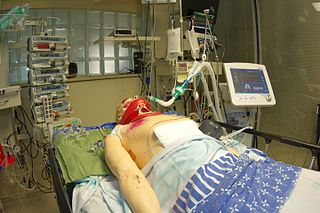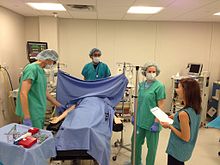
A simulation is an imitative representation of a process or system that could exist in the real world. In this broad sense, simulation can often be used interchangeably with model. Sometimes a clear distinction between the two terms is made, in which simulations require the use of models; the model represents the key characteristics or behaviors of the selected system or process, whereas the simulation represents the evolution of the model over time. Another way to distinguish between the terms is to define simulation as experimentation with the help of a model. This definition includes time-independent simulations. Often, computers are used to execute the simulation.

In a physical examination, medical examination, or clinical examination, a medical practitioner examines a patient for any possible medical signs or symptoms of a medical condition. It generally consists of a series of questions about the patient's medical history followed by an examination based on the reported symptoms. Together, the medical history and the physical examination help to determine a diagnosis and devise the treatment plan. These data then become part of the medical record.
Step 2 Clinical Skills of the United States Medical Licensing Examination (USMLE) was an exam administered to medical students/graduates who wish to become licensed physicians in the U.S. It is similar to the COMLEX-USA Level 2-PE exam, taken by osteopathic medical students/graduates who seek licensure as physicians in the U.S. For US medical students, the exam fee is $1,300. For medical students at non-US medical schools, the tests cost is higher—currently $1,535. These fees do not include costs associated with travel and lodging to take the test. Historically, US students have taken Step 2 CS late in their senior year, prior to graduation. However, now that more residency programs require students to record a passing score, many US medical schools recommend students take Step 2 CS in the fall of their senior year.

Medical education is education related to the practice of being a medical practitioner, including the initial training to become a physician and additional training thereafter.
Roleplay simulation is an experiential learning method in which either amateur or professional roleplayers improvise with learners as part of a simulated scenario. Roleplay is designed primarily to build first-person experience in a safe and supportive environment. Roleplay is widely acknowledged as a powerful technique across multiple avenues of training and education.
An objective structured clinical examination (OSCE) is an approach to the assessment of clinical competence in which the components are assessed in a planned or structured way with attention being paid to the objectivity of the examination which is basically an organization framework consisting of multiple stations around which students rotate and at which students perform and are assessed on specific tasks. OSCE is a modern type of examination often used for assessment in health care disciplines.
The Comprehensive Osteopathic Medical Licensing Examination of the United States (COMLEX-USA) is a series of three osteopathic medical licensing examinations administered by the National Board of Osteopathic Medical Examiners (NBOME) similar to the United States Medical Licensing Examination (USMLE). COMLEX-USA is the most common pathway by which osteopathic physicians (D.Os) apply for medical licensure, and is accepted in all 50 states. The 3-digit standard scores of COMLEX-USA Level 1, Level 2- Cognitive Evaluation (CE), and Level 3 have a range of 9-999 and a mean of 500. Most candidates score between 250 and 800. 400 is the minimum passing score for COMLEX-USA Levels 1 and 2; 350 for COMLEX-USA Level 3. It was announced on January 24, 2022 that the COMLEX-USA Level 1 examination will be moving from a 3-digit numeric score to solely pass/fail beginning on May 10, 2022.
The term virtual patient is used to describe interactive computer simulations used in health care education to train students on clinical processes such as making diagnoses and therapeutic decisions. Virtual patients attempt to combine modern technologies and game-based learning to facilitate education, and complement real clinical training. Using virtual patients is increasing in healthcare due to increased demands on healthcare professionals, education of healthcare trainees, and providing learners with a safe practice environment. There are many formats from which a virtual patient may be chosen, but the overarching principle is that of interactivity. Virtual patients typically have mechanisms where information is parsed out in response to the learners, simulating how patients respond to different treatments. Interactivity can be created with questions, specific decision-making tasks, text composition, etc., and is non-sequential. Most systems provide quantitative and qualitative feedback. In some cases, virtual patients are not full simulations themselves, but are mainly based on paper-based cases; as they do not allow for physical examination or an in-depth medical history of an actual patient. There are certain drawbacks as crucial clinical findings may be missed due to the lack of examining patients in person.
Southern Illinois University School of Medicine is a medical school located in Springfield, the capital of the U.S. state of Illinois. It is part of the Southern Illinois University system, which includes a campus in Edwardsville as well as the flagship in Carbondale. The medical school was founded in 1970 and achieved full accreditation in 1972. It was founded to relieve a chronic shortage of physicians in downstate Illinois.

Emergency nursing is a specialty within the field of professional nursing focusing on the care of patients who require prompt medical attention to avoid long-term disability or death. In addition to addressing "true emergencies," emergency nurses increasingly care for people who are unwilling or unable to get primary medical care elsewhere and come to emergency departments for help. In fact, only a small percentage of emergency department (ED) patients have emergency conditions such as a stroke, heart attack or major trauma. Emergency nurses also tend to patients with acute alcohol and/or drug intoxication, psychiatric and behavioral problems and those who have been raped.

The University of New Mexico School of Medicine is a division of the University of New Mexico Health Sciences Center located in Albuquerque, New Mexico. The UNM School of Medicine is home to a variety of degree-granting programs, including the only MD program in the state.
Hertfordshire Intensive Care & Emergency Simulation Centre (HICESC) is an advanced teaching facility based at the University of Hertfordshire. At its creation in 1998, it was an inter-Faculty practical laboratory hosted by the Department of Electronic, Communication and Electrical Engineering (ECEE) for access by medical engineering students and jointly established by the Department of Nursing and Paramedic Sciences, Faculty of Health and Human Sciences for use by their students.
Clinical clerkships encompass a period of medical education in which students – medical, nursing, dental, or otherwise – practice medicine under the supervision of a health practitioner.

Medical simulation, or more broadly, healthcare simulation, is a branch of simulation related to education and training in medical fields of various industries. Simulations can be held in the classroom, in situational environments, or in spaces built specifically for simulation practice. It can involve simulated human patients, educational documents with detailed simulated animations, casualty assessment in homeland security and military situations, emergency response, and support for virtual health functions with holographic simulation. In the past, its main purpose was to train medical professionals to reduce errors during surgery, prescription, crisis interventions, and general practice. Combined with methods in debriefing, it is now also used to train students in anatomy, physiology, and communication during their schooling.
An instructional simulation, also called an educational simulation, is a simulation of some type of reality but which also includes instructional elements that help a learner explore, navigate or obtain more information about that system or environment that cannot generally be acquired from mere experimentation. Instructional simulations are typically goal oriented and focus learners on specific facts, concepts, or applications of the system or environment. Today, most universities make lifelong learning possible by offering a virtual learning environment (VLE). Not only can users access learning at different times in their lives, but they can also immerse themselves in learning without physically moving to a learning facility, or interact face to face with an instructor in real time. Such VLEs vary widely in interactivity and scope. For example, there are virtual classes, virtual labs, virtual programs, virtual library, virtual training, etc. Researchers have classified VLE in 4 types:

Harvey was one of the earliest medical simulators available for training of health care professionals. Harvey was created in 1968 by Dr. Michael S. Gordon at the University of Miami. Harvey is currently sold by the Laerdal Corporation.

Howard S. Barrows was an American physician and medical educator who was Professor Emeritus at the Southern Illinois University School of Medicine where he had previously served as Associate Dean for Educational Affairs and Chair of Medical Education. Trained as a neurologist, Barrows is best known today for his many innovations in medical education, particularly teaching using Problem-Based Learning (PBL), developed while he was a professor at McMaster University Medical School, assessing clinical skills using simulated patients, and studying clinical reasoning using stimulated recall techniques.
Valdecilla virtual Hospital (VvH) is a healthcare simulation center located in the city of Santander, Cantabria, Spain. It was created by a consortium between the Cantabrian Government, the Marqués de Valdecilla University Hospital, and the University of Cantabria.
Acıbadem University School of Medicine is one of the graduate schools of Acıbadem University. Acıbadem University is a private, non-profit institution, founded in 2007 and located in Istanbul, Turkey. The University is supported by the financial resources of the Kerem Aydınlar Foundation, set up by Mehmet Ali Aydınlar. Mehmet Ali Aydınlar is a leading Turkish businessman and the largest shareholder and CEO of the Acıbadem Healthcare Group, Turkey's leading healthcare institution that was founded in 1992.

MSR – The Israel Center for Medical Simulation is Israel's national institute for simulation-based medical education (SBME) and patient safety training. It is located at the Chaim Sheba Medical Center in the Tel HaShomer neighborhood of Ramat Gan, in the Tel Aviv District. MSR is internationally recognized as leader in patient safety simulation-based training.









